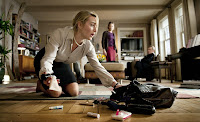In 2009 the
Swedish The Girl with the Dragon Tattoo
was a surprising success. The adaptation of the first of Stieg Larsson books
was far from perfect, but it was kind of refreshing. Somehow, the studios in
Hollywood must have been jealous, and why wouldn’t it be a bad idea to make an
American adaptation of the Swedish books? And with a very gifted director like
David Fincher (Se7en, Fight Club, Zodiac) a (financial) success is guaranteed.
For those
who haven’t read the book or seen the first movie: Mikael Blomkvist (Daniel
Craig) is a journalist who just lost a big lawsuit against a rich and powerful
businessman. Henrik Vanger (Christopher Plummer), from the Vanger concern, one
of Sweden’s biggest family-companies, hires Blomkvist to investigate the apparent
murder of his favourite niece Harriet who disappeared more than 40 years ago.
Before hiring Blomkvist, Vanger had him checked by the very talented but disturbed Lisbeth Salander
(Rooney Mara) who will later join Blomkvist as his assistant investigator. Together they find out that the Vanger family has a very disturbing history.
Fincher
opens with stunning credits conducted by a techno version of Led Zeppelin’s Immigrant Song, which is not only a good
choice lyrically but adds to the irony of reusing original material. The
credits make you feel you are about to watch a James Bond movie, which is
almost confirmed even when we see the first shot of Daniel Craig. Luckily these
associations don’t last very long and Craig shows us a credible Mikael
Blomkvist.
Just to be
clear, strictly this movie is not a remake of the Swedish film. It is a
re-adaptation of the Larsson book and the makers made a few choices that are fairly
different compared to the first movie. Not only is the plot different in some
aspects, although the main part is exactly the same, but the characters are portrayed
differently. Let’s start with the character whose shoes are probably the
hardest to fill: Lisbeth Salander. Rooney Mara does an excellent job in playing
the disturbed but brilliant hacker genious. In 2009, Rapace showed us a very though,
distant and violent girl whereas Mara is cuter and seems more fragile. That she
possesses the necessary evil and violent qualities is shown adequately in the revenge
scenes with her pervert guardian Bjurman (a good role from the Dutch Yorick van
Wageningen). The main difference in her character is the affection she develops
for Blomkvist (I will try not to spoil too much) where Rapace was distant and
couldn’t show any intimacy towards men, which makes sense regarding some of the
disturbing developments during the movie. The ‘love’ scenes between Blomkvist
and Salander therefore seem unlikelier than in the Swedish version.
My biggest
objection against this movie is the way in which the Vanger family is shown to
the viewer. Henrik Vanger promises Blomkvist that he will get to know each
member of the family more than he will like to. This couldn’t be less true for
the viewers of this film. In the Swedish version we get to know some of the members
or at least there reputation quite well. This creates a different suspense and
drags you more into the family mystery. In Fincher’s one this isn’t done in a
satisfying manner. Some of the choices in how to tell this story work very well, but for instance the different twist in the end is one that doesn't require a lot of creativity. The director does manage to use his talent with beautiful style
and he adds his trademark dark tones to the storytelling and effective
cinematography. Therefore, I wouldn’t say Fincher is disappointing me with this
movie, except that I would like to see him make more original films.
The Girl
with the Dragon Tattoo is not a bad movie, but the original version is too
recent for a ‘remake’ in my opinion. Perhaps this one is a better adaptation
(I haven’t read the book), it sure is not an improvement on the 2009 film. Maybe
Americans should consider recording an English audio track next time….
6/10















